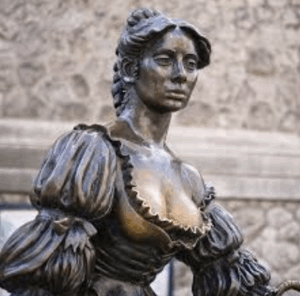
Molly Malone is a woman featured in an Irish folk song. Legend has it that Molly sold mussels and clams until she died of a fever in the 17th century. While it is unknown whether Molly was real, or purely fictional, her story is known across Ireland. Due to her popularity, a statue of Molly was erected on Suffolk Street, in Dublin Ireland, in December of 1988. The statue of Molly quickly became a popular tourist attraction. However, over the years the statue has come under controversy. This is not due to the statue of
Molly itself, but how people interact with her.
It started as a superstition. People began rubbing Molly as a way of ensuring that they would have good luck. Others rubbed her as a way of ensuring that they would return to Ireland someday. Tour guides spoke of these superstitions, and it quickly became common practice to rub Molly. Unfortunately, what began as an innocent form of goodluck became an act of disrespect.
Disrespectful tourists began to rub Molly’s breasts, leaving this specific part of the statue with extreme discoloration. Tourists are often photographed groping Molly. Not only has the practice been harmful to the statue, but it is also representative of the objectification that women all around the world endure on a daily basis. The discoloration of the statue is indicative of a larger problem, violence against women. The state of the statue has led to much criticism and backlash. In response, The Dublin City Council put into place a campaign called “Leave Molly mAlone”. Others took it upon themselves to plant flower beds around the statue, in order to take focus away from Molly. Nevertheless, the objectification of the statue has not diminished. The city of Dublin recently went as far as taking them away to repaint the parts that had been discolored, only for the discoloration to quickly return once Molly had been put back. Not only is this disrespectful to the artist, and the statue itself, but to Molly and the rest of the women around the world. Just because a statue of a woman is somewhat immodest does not mean that people have the right to objectify and grope it. This issue is deeply layered, and not just a funny gag for a picture. The objectification portrays a lack of respect for women and their bodies, and the disrespect of a wonderful piece of art.







